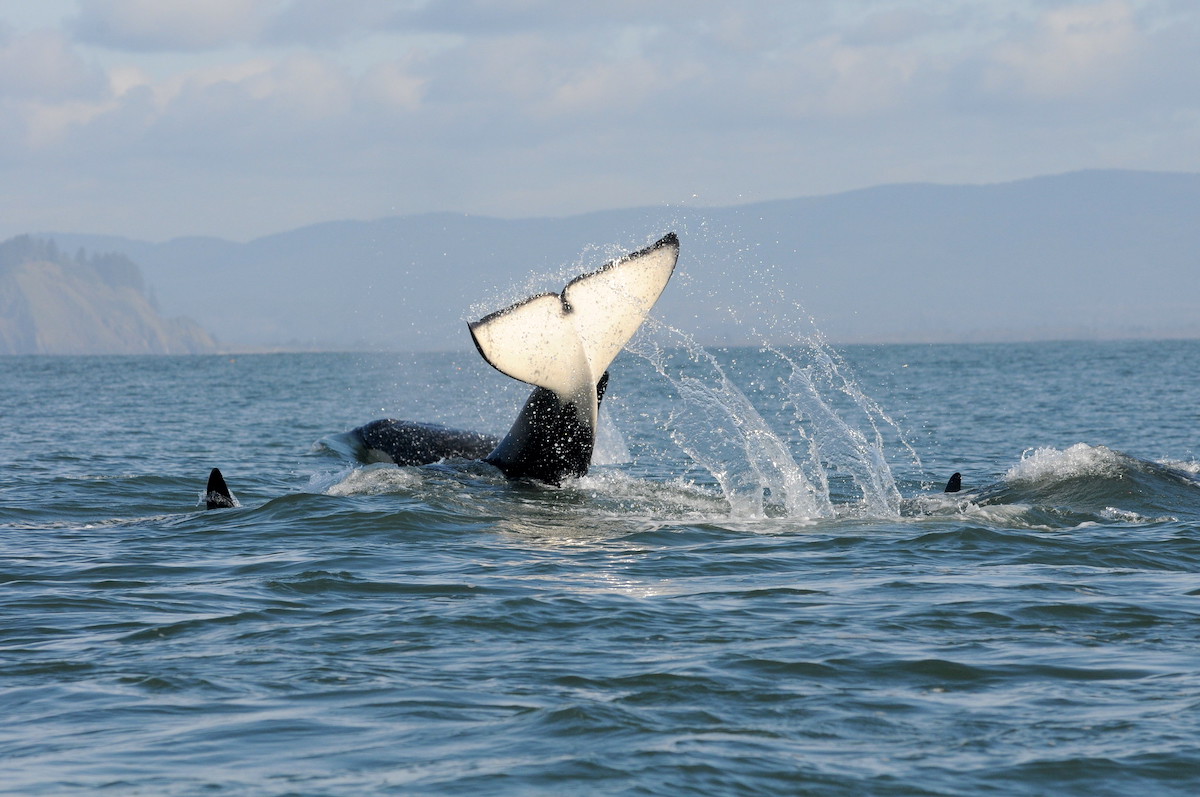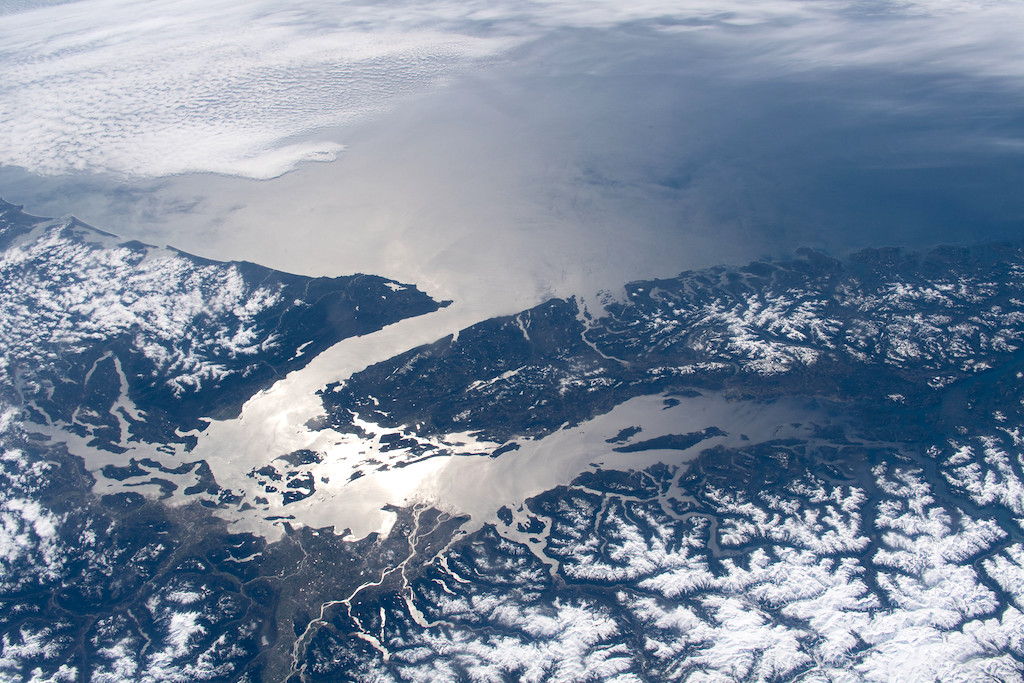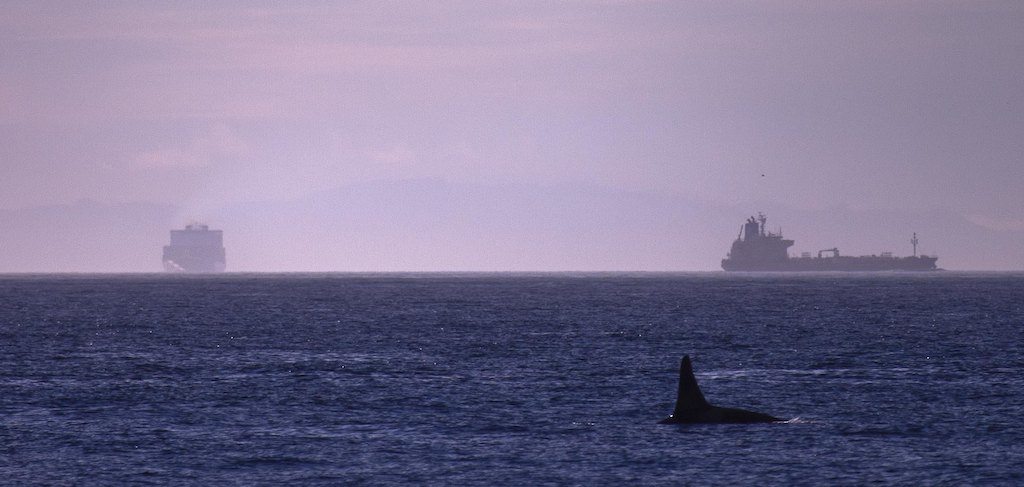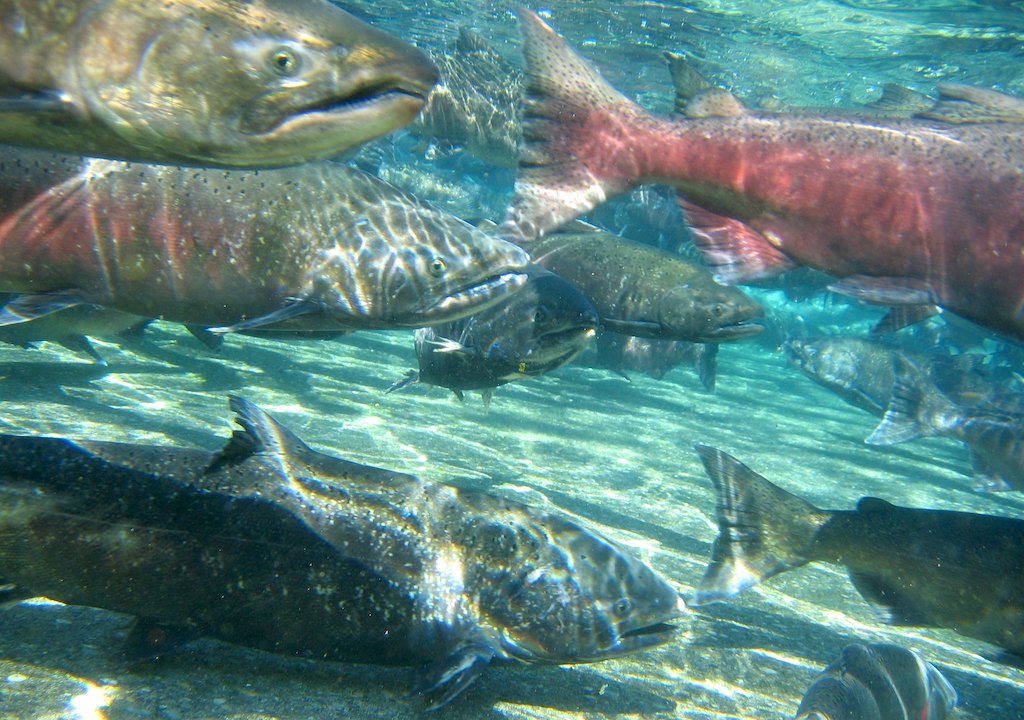There’s an imaginary line that sweeps along the length of the Strait of Juan de Fuca and zigzags north through Haro Strait and between the San Juan and Gulf Islands. The line represents an international border, demarcating the frontier between the United States and Canada. It’s also a major shipping lane, connecting Vancouver, Seattle, and other Salish Sea ports to the web of global commerce. For the southern resident orcas, it’s simply a part of home – a vector traveling through some of their most important habitat.

The Salish Sea’s endangered southern resident orcas travel freely across the U.S.-Canada border, unconstrained by political boundaries. But while they don’t require passports, they can still face differing policies and conditions as they go back and forth between nations. We look at some of the ways that the United States and Canada compare in their efforts to protect the whales.


The Strait of Juan de Fuca and the Salish Sea, pictured from the International Space Station, separate the western-most border of the United States and Canada. NASA
This economically important, politically complex, and ecologically vital strip of water is a kind of microcosm that illustrates just how challenging it will be to protect these whales, which are listed as endangered in both the United States and Canada. The population now numbers just 73 individuals and has been the focus of increasing public concern.
“In the last two to three years, things have really come to a head,” Georgia Strait Alliance executive director Christiane Wilhelmson said at a Salish Sea Ecosystem Conference virtual plenary session on orca protection measures in April. “Both in British Columbia and Washington, there's been a huge amount of effort” to improve protections for the whales.
Washington State’s Southern Resident Orca Task Force launched in March 2018 and released its final report in November 2019; its recommendations are now being considered by state and federal policymakers. Meanwhile, Canada formed a series of working groups to tackle various threats to the population; these groups are continuing to deliberate and to roll out their recommendations.
These and other processes have already resulted in new and strengthened measures to reduce noise and disturbance from vessels of all sizes in the Salish Sea, and to increase the availability of the orcas’ preferred food, Chinook salmon. “The U.S. and Canada have done an admirable job of trying to work together on this,” says Joe Gaydos, science director of the nonprofit SeaDoc Society.
But public concern is difficult to translate into effective protection for a long-lived species that ranges widely across international borders. The two countries’ measures are similar in spirit and intent but haven’t been perfectly aligned. For example, salmon habitat restoration measures have thus far been stronger in the United States, while sanctuaries and exclusion zones to keep people out of the whales’ favorite spots have been more common in Canada.
Some measures are voluntary on one side of that imaginary line in the Salish Sea and mandatory on the other, or temporary on one side of the border and permanent on the other. And some measures differ in their arcane detail – which could make them difficult for people to adhere to and authorities to enforce, advocates say.
And the Lummi Nation, which has been among the most vocal of the region’s Indigenous groups pressing to ensure the whales’ well-being, say that much more radical efforts are necessary – ones that honor the millennia-long relationships between the orcas and the first peoples of the Salish Sea region.
Noise and disturbance
Noise from large commercial vessels such as cruise ships, container ships, tankers, barges, and ferries can make it harder for southern resident orcas to navigate, communicate, and find prey through echolocation. The Enhancing Cetacean Habitat and Observation (ECHO) program, run by the Vancouver-Fraser Port Authority, has been working to address vessel noise since 2014.

Noise from large commercial vessels can interfere with orca navigation and communication. Photo: Clark Fork Photography (CC BY-NC 2.0)
The program is “a real gem,” says Michelle Sanders, director of clean water policy with Transport Canada's environmental policy group. It brings together a variety of marine stakeholders including shipping associations, pilots’ associations, BC ferries, scientists from Vancouver Aquarium, government representatives, environmental groups, and First Nations representatives.
The ECHO program’s main outcome has been a voluntary slowdown of shipping traffic – slower vessels aren’t as loud. In 2019, 82% of large vessels traveling to or from the Port of Vancouver through shipping lanes in Haro Strait and Boundary Pass participated in the program. This reduced underwater noise intensity by half.
The slowdown of Canadian port traffic has cross-border benefits, quieting the environment for southern residents in U.S. waters on the west side of San Juan Island, one of their favorite summer foraging spots, says Lynne Barre, director of southern resident orca recovery at the National Oceanic and Atmospheric Administration (NOAA).
NOAA is investigating starting a similar program that would cover ships in inland waters going to or from Seattle and Tacoma during certain times of year when the orcas are likely to be present, Barre adds – one of the Washington orca task force recommendations.
Ferries make a disproportionate contribution to vessel noise in the Salish Sea because “they make more transits than virtually any other large vessel,” says Michael Jasny, director of the marine mammal protection program for the Natural Resources Defense Council. Both Washington and British Columbia are taking steps to limit noise from ferries, including making plans to purchase quieter vessels.
Smaller vessels like pleasure craft and whale watching boats are not as loud as big tanker and container ships, but especially at high speeds they tend to emit noises at higher frequencies that overlap more with those used by orcas. They’re also more numerous, and more likely to come into closer proximity with the whales – which could cause the orcas to be stressed or alter their behavior.
The United States and Canada have employed three strategies to limit small vessels’ impact on the southern residents: sanctuaries, speed limits, and distance limits.
Canada has established sanctuary zones at Swiftsure Bank on the west coast of Vancouver Island, off the east side of Saturna Island, and southwest of North Pender Island. Boating and fishing are prohibited in these areas, although the carve-outs are not permanent. In the United States, there’s a voluntary no-boat zone on the west side of San Juan Island.
Both countries have established speed limits of 7 knots in the vicinity of killer whales. Washington law specifies that boaters must go slow within ½ mile of southern residents. In Canada, a voluntary guideline asks boaters to adhere to that limit within 1,000 meters of any killer whales in southern resident critical habitat.
In Canada, boaters are prohibited from approaching within 400 meters of killer whales in southern resident critical habitat. Washington State law says boaters must stay 300 yards away from southern residents along the sides, and 400 yards out of the whales’ path from ahead or behind.
“We're very happy that we've got some of these key measures that afford the southern residents a little more space and quiet time,” says Todd Hass, special assistant to the executive director of the Puget Sound Partnership.
But Hass and others acknowledge that the differences between the two countries could cause confusion. “When we tried to put our updated Be Whale Wise brochure together, we realized, man, this is very complicated,” says Barre, referring to a cross-border boater education program. “I think it'll be a goal for all of us to work towards something that is more aligned and consistent.”
Canada has special provisions for the whale watching industry, which may in the end be more protective than the general U.S. regulations, Jasny argues. Canadian whale watch boats are allowed to come within 200 meters of transient orcas but are essentially prohibited from watching southern residents at all. Such a policy “is just going to be a heck of a lot more effective than one that still allows watching albeit at slightly larger distances that that can be hard to maintain,” he says.
The salmon factor
Aside from limiting noise and disturbance from vessels, the other major focus of orca protection efforts has been making sure the whales have enough to eat. This is complicated because the southern residents’ preferred prey is Chinook salmon. During the summer months, the whales rely on fish from Fraser river and Puget Sound runs that have been severely depleted. “We're trying to recover an endangered species that eats another one,” Gaydos says.
In response to the orca task force recommendations, during its 2019 and 2020 sessions the Washington State legislature strengthened habitat protections, implemented new incentives for landowners to preserve and create habitat, and provided funding to restore habitat and remove barriers to fish passage.

Adult fall Chinook salmon. Photo: Pacific Northwest National Laboratory (CC BY-NC-SA 2.0)
Both the United States and Canada have also taken steps to increase production of hatchery salmon – a stopgap measure to some extent. “Long term, you need to have habitat and protection. But in the short term, to get food to the orcas, you need to have hatcheries,” says Eric Netherland, executive coordinator of the governor's salmon recovery office in Washington State.
But some argue that relying on hatchery salmon is counterproductive. Hatchery fish don’t survive as well in the ocean, compete with wild stocks, and do little for the summer salmon runs that are so crucial to the southern residents’ diet, says Misty MacDuffee, a biologist with the Raincoast Conservation Foundation.
They also prop up unsustainable ocean-based fisheries, she adds. “We've got to move fisheries to what's called terminal areas, which is close to the river or near the river. And that way whales get access to them before the fisheries occur.”
The Lummi Nation, whose traditional territories include the San Juan Islands and coastal areas between Vancouver and Seattle, has called for the restoration of salmon populations in the Salish Sea to 1985 levels. “The health of the Salish Sea can be measured in salmon,” reads a document prepared by the tribe’s Sovereignty and Treaty Protection Office.
“While we would like to see pre-contact levels of salmon restored….The salmon population in 1985 sustained both our people and qwe ‘lhol mechen,” it continues, referring to the Lummi term for orcas, which translates as ‘our relations below the waves.’
The status of orcas as relatives in the Lummi traditional worldview drives the tribe’s conservation strategy for the southern residents, which Sovereignty and Treaty Protection Office strategist Kurt Russo describes as ‘spiritual sovereignty.’ Spiritual sovereignty includes the right to use ancestral knowledge to guide conservation actions, he explains, and the right to have the intangible relationships between things respected and protected – relationships like those between the Lummi people and the orcas.
One important conservation action guided by ancestral knowledge is the spiritual feeding ceremony, in which Lummi representatives take a live Chinook salmon out to the Salish Sea and release it to feed the spirit of the southern residents. “They're feeding the spirit of their relations,” Russo says of this practice. “That is a conservation strategy.”
The Lummi have clashed with NOAA over the necessity for permits for this activity, but have vowed to continue, Russo says. “The way Native people signify qwe ‘lhol mechen is not the way NOAA signifies southern resident killer whales. They're not the same thing. So, they're not going to have the same idea of what's needed to bring them back to health.”
Is it working?
Documenting whether protective measures are actually helping the southern resident population on their way back to health is another complex undertaking. Because orcas are long-lived and slow to reproduce, effects are often difficult to demonstrate on a short time scale.
Researchers are using hydrophones to monitor sound in the Salish Sea to determine whether speed limits, exclusion zones, and sanctuaries are making the whales’ environment quieter. They are watching boats to see if they are really going slower and staying farther from the whales as they are supposed to.
They’re also tracking the whales’ movements to see if they are spending more time in quiet areas and sanctuary zones, and monitoring behavior to see how the orcas act in the presence or absence of vessels and in quieter surroundings.
But these are mostly proxy measurements. “The real-time information from the actual physical condition of whales is probably the best indicator for how we're doing,” MacDuffee says. One of the few sources of this real-time information is photogrammetry, in which researchers use drones to capture pictures of the whales from above that can indicate how whales are growing and how fat they are.
“Our data has emerged as being very sensitive to be able to provide a kind of quick health check for the whales,” says John Durban, a retired NOAA biologist now with Southall Environmental Associates and one of the pioneers of aerial photogrammetry. “Let's say there was an area closure for fisheries. We can detect how animals did before and after that,” Durban says – although he cautions that scientists must take care to examine other environmental variables at play, such as the strength of salmon runs in a particular year. As for salmon, fisheries biologists hope to see the effects of investments in hatchery production yield better survival and more fish within two to five years, says Netherland. Ultimately, though, when it comes to improved survival and reproductive success that will enable the southern residents to rebuild their population, “that's really a generational fix.”

